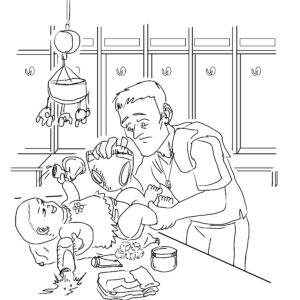One of the things that some new dads find surprising is that cleaning dirty bottoms isn’t as bad as they thought it might be. For a few, the mere whiff of a soiled nappy is enough to make them wretch and make for the exit. Dad F.C. is keen for these managers to man-up and get involved here. You’re going to need to become acquainted with dirty nappies and like anything, practice makes perfect.
How often your little one needs to be changed depends on a number of things, including their age, what they’re consuming and how sensitive their skin is. In the early days, it’s usual to change the nappy up to about 10-12 times a day. A soiled nappy should be changed immediately or as soon as possible to avoid both discomfort and nappy rash. A wet nappy could be changed immediately or you could wait until before or after a feed (whichever seems right for your baby – as long as they’re comfortable and not getting a rash).

What kit do you need to change a nappy?
- Changing mat
- Towel (as a spare or in place of the changing mat)
- Fresh nappy
- Cotton wool
- Warm water
- Baby wipes (sensitive non-alcohol type are best)
- Nappy sack (for the dirty nappy and dirty cotton wool)
- Cream (nappy rash cream for keeping baby’s bum protected)
- Clean clothes
Extra nappy changing kit worth considering
- A nappy holder (for storing all the fresh nappies nearby)
- A baby changing table or a cot-top changer (this can avoid back pain but keep your eye on your baby at all times as they have an incredible knack of doing their first roll at just the wrong time)
- Dirty laundry basket nearby (you’ll be emptying this basket regularly, but it helps to have a laundry basket nearby so you can throw dirty clothes straight into it, before taking it all to the washing machine)
- Cleaning spay: to wash the changing mat clean after use. Use a baby wipe to wipe clean.

It’s a little known secret (or evolutionary fact) that some parents can distinguish their own baby’s smelly nappy from another baby’s.
How to change a nappy
- Wash your hands.
- Lay the little one down on the mat, remove their clothes (or lift the clothes up if the clothes are not dirty and don’t need to be changed) and open the nappy
- Lift the baby’s legs up by using one hand to lift up at ankles.
- If the baby has done a number 2 (poo) then use the nappy to wipe as much of the poo into the nappy. Close the dirty nappy and keep it under the baby’s bum to avoid the baby’s dirty bum touching the changing mat.
- Grab a piece of cotton wool, dab it in the warm water and clean the rest of the poo off the baby’s skin. If your baby has just done a number 1 (wee) then you still give your baby the same good clean, always being careful to wipe between the folds of their chubby legs.
- Once fully cleaned, remove the dirty nappy from beneath the baby and place the dirty nappy and the used cotton wool balls inside a nappy bag.
- Have a good chat with your baby when you’re doing this. This is a decent time to bond, so pull faces and have a giggle. You want to make sure your baby has a healthy relationship with going to the toilet and doesn’t get any negative vibes about doing a number 1 or 2.
- Grab a fresh nappy, open it and place it, open side up, under your baby.
- Let go of his little ankles and bring the front side of the nappy up, so it sits comfortably around his belly. For a boy, make sure his penis is down, rather than up – otherwise next time he goes for a wee you’ll all get covered.
- Bring the left and right folds over, sticking them snugly (not tightly) onto the front of the nappy. If your baby still has an umbilical cord stump then roll the front of the nappy so that the cord is not touching nor covered by the nappy.
For professionals: move Step 8 forward to after Step 3. Placing a clean nappy underneath the dirty nappy removes the corridor of uncertainty when you take the dirty nappy off and your baby might piss all over the place.
Showboat: The Shoulder Flap Flip
Most baby onesies and vests are designed with shoulder flaps. You can flick these shoulder flaps inside out, bringing your baby’s arms up comfortably through the neck of the vest, and pull or roll the onesie down over their legs rather than over their head. Why do you care? Because this avoids getting dirt all up your baby’s back if you were to pull a dirty onesie over their head.
Once you’ve mastered this, you’ll never go back to pulling a shitty nappy over your baby’s head again!
